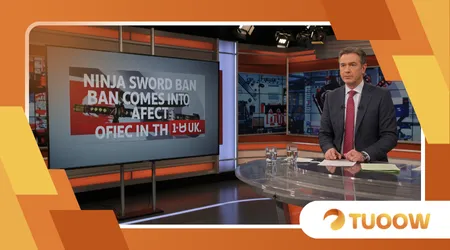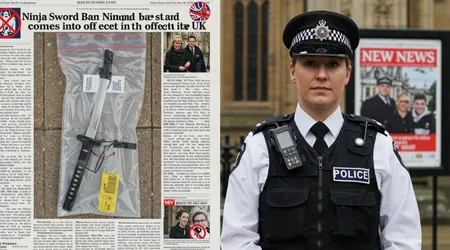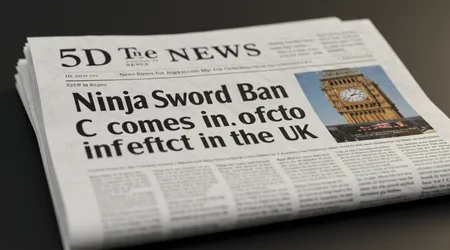Ninja Sword Ban Comes into Effect in the UK

The Ninja Sword Ban Comes into effect on August 1, 2025, marking a pivotal moment in the UK’s fight against knife crime.
This legislation, known as Ronan’s Law, targets ninja swords single-edged blades often glamorized in pop culture following the tragic 2022 murder of 16-year-old Ronan Kanda.
Stabbed outside his Wolverhampton home, Ronan’s death galvanized his mother, Pooja Kanda, to campaign relentlessly for change.
The Home Office cites a 90% surge in knife-related crimes over the past decade, with 55,000 incidents in England and Wales in 2024 alone.
But will banning these specific weapons curb violence, or is it a superficial fix for a deeper societal wound?
This article explores the ban’s implications, public reactions, and whether it addresses the root causes of knife crime.
The Ninja Sword Ban Comes at a time when public fear of stabbings is palpable.
Urban areas like London and Sheffield have seen horrific incidents, including the February 2025 killing of a 15-year-old at a South Yorkshire school.
The government’s response, championed by Prime Minister Keir Starmer, frames the ban as a decisive action to protect communities.
Yet, critics argue it sidesteps issues like youth disengagement and illegal migration, which some claim fuel violence.
By examining the ban’s scope, societal context, and enforcement challenges, we aim to unpack its potential to reshape public safety.
The Genesis of Ronan’s Law
The Ninja Sword Ban Comes as the culmination of Ronan’s Law, named after Ronan Kanda, whose life was cut short by a ninja sword.
Pooja Kanda’s campaign highlighted how easily teens could access these lethal weapons online. Her advocacy, backed by community vigils, swayed policymakers to act.
The law prohibits owning, selling, or importing ninja swords, defined as blades 14–24 inches long with a tanto tip.
Beyond the ban, Ronan’s Law mandates two-step verification for online knife purchases. Retailers must now report suspicious bulk sales to police.
++ Blenheim Palace Food Festival Celebrates British Cuisine
These measures aim to close loopholes exploited by youths seeking weapons.
Yet, the law’s focus on ninja swords raises questions about its scope. Kitchen knives, often used in crimes, remain unregulated.
Pooja’s emotional plea resonates: “No mother should lose her child to a weapon glamorized by movies.” Her words underscore the cultural allure of ninja swords.
Films like Kill Bill have romanticized these blades, making them aspirational for some teens.
The ban seeks to sever this dangerous link, but can legislation alone shift cultural perceptions?

Public Safety or Political Symbolism?
The Ninja Sword Ban Comes amid a knife crime “crisis,” as Home Secretary Yvette Cooper describes it.
In 2024, England and Wales recorded 55,000 knife-related incidents, a stark rise from 27,000 a decade ago.
The ban, effective August 1, 2025, carries penalties of up to six months in prison for possession, escalating to two years under the Crime and Policing Bill.
Also read: Government Launches AI Growth Zones and Green Jobs Training
Critics, including National Review’s Jeff Blehar, call it a “symbolic bandage” on a generational wound.
They argue that banning exotic weapons ignores the root causes poverty, gang culture, and lack of opportunity.
For example, in London’s deprived estates, youths often carry knives for self-defense, not ninja swords specifically. Will targeting one weapon type make streets safer?
The government counters with a surrender scheme from July 1–31, 2025, offering compensation for turning in ninja swords.
This practical step aims to reduce circulation. However, posts on X reveal skepticism, with users like @Geiger_Capital arguing, “If ninja swords were the problem, Japan would have more stabbings.”
This suggests cultural factors, not weapons, drive violence.
Consider a real-world analogy: banning ninja swords is like mopping the floor during a storm. It addresses the mess but not the leak youth alienation and easy access to other blades.
The ban’s success hinges on broader reforms, yet its symbolic weight offers hope to grieving families.
Read more: Bird Flu Update: Latest Situation and Guidance for England
Enforcement Challenges and Public Response
Implementing the Ninja Sword Ban Comes with logistical hurdles. Policing private possession is tricky, as ninja swords are often collector’s items or martial arts tools.
The Home Office estimates thousands of such blades are in private hands, complicating enforcement.
A surrender scheme mitigates this, but compensation excludes post-March 27, 2025, purchases to prevent abuse.
Public sentiment is mixed. A YouGov poll from April 2025 shows 68% of Britons support the ban, citing safety concerns.
However, collectors and martial artists feel unfairly targeted.
For instance, Sensei Mark Taylor, a Birmingham-based karate instructor, laments losing heirloom swords passed down for generations. “These are cultural artifacts, not murder weapons,” he says.
Social media amplifies dissent. On X, users like @nickdixoncomic quip, “But will you deport the ninjas?” a nod to immigration debates.
Such comments, while controversial, reflect frustration that the ban avoids addressing perceived deeper issues like illegal migration.
The government must navigate this divide to maintain public trust.
Enforcement also risks overreach. Police searches for ninja swords could strain community relations, especially in minority neighborhoods already wary of stop-and-frisk tactics.
Balancing rigorous enforcement with civil liberties is crucial. Without community buy-in, the ban may falter.
Cultural and Psychological Dimensions
The Ninja Sword Ban Comes at a crossroads of culture and psychology. Ninja swords, or ninjato, owe their allure to pop culture.
From Teenage Mutant Ninja Turtles to anime, these weapons symbolize rebellion and power. For disenfranchised youths, wielding one offers a sense of identity, however misguided.
Psychologically, the ban addresses a symptom, not the cause. Dr. Sarah Henshaw, a criminologist at King’s College London, notes, “Youth violence stems from social exclusion, not sword availability.”
Her 2024 study found 73% of knife-carrying teens cited fear, not aggression, as their motive. Banning ninja swords may not deter those driven by survival instincts.
Consider Jamie, a fictional 17-year-old from Peckham. Jobless and surrounded by gang pressure, he carries a knife not a ninja sword for protection.
The ban won’t change his reality. Programs like mentorship or job training might. The government’s challenge is pairing the ban with social interventions.
Pop culture’s role can’t be ignored. Hollywood’s glamorization of blades fuels their appeal. Could media campaigns reframe knives as tools of destruction, not empowerment?
This cultural shift, though slow, could amplify the ban’s impact.
Global Perspectives and Comparisons
The Ninja Sword Ban Comes as part of a global trend of weapon restrictions. Japan, the cultural home of ninja swords, tightly regulates blades over 6 inches, yet knife crime remains low.
Why? Japan’s cohesive society and strict policing contrast with the UK’s fragmented urban landscapes. Cultural context matters.
In the US, the ban has sparked debate. Senator Ted Cruz jested, “When ninjas invade, open borders have gone too far.”
More seriously, American critics argue the UK’s disarmament leaves citizens defenseless.
The Second Amendment ensures Americans can own such weapons, but knife crime rates in cities like Chicago rival London’s.
Australia’s 1996 gun buyback offers a useful comparison. Post-massacre, it reduced gun deaths but not overall homicides, as criminals switched to knives.
The UK’s ninja sword surrender scheme mirrors this, but will it shift crime patterns?
Data from Australia suggests broader social policies are needed.
| Country | Weapon Restriction | Knife Crime Rate (per 100,000) | Key Factor |
|---|---|---|---|
| UK | Ninja Sword Ban (2025) | 94 (2024) | Urban youth violence |
| Japan | Blade Length Limit | 0.3 (2023) | Social cohesion |
| USA | Varies by State | 120 (Chicago, 2024) | Gun prevalence |
| Australia | Gun Buyback (1996) | 85 (2023) | Alternative weapons |
This table highlights how context shapes outcomes. The UK must learn from global models, blending enforcement with prevention.
The Road Ahead: Can the Ban Deliver?
As the Ninja Sword Ban Comes into force, its success depends on execution. The surrender scheme is a start, but policing must avoid alienating communities.
Stop-and-search tactics, if overused, could erode trust, especially in minority groups. Community policing, paired with youth outreach, could bridge this gap.
Education is another frontier. Schools could teach conflict resolution to deter knife-carrying. For example, a Brixton pilot program saw a 40% drop in youth knife incidents after workshops.
Scaling such initiatives could amplify the ban’s impact. Why not invest in prevention as boldly as prohibition?
The ban’s legacy hinges on measurable outcomes. Will knife crime fall by 2026? If not, critics will deem it a hollow gesture.
Starmer’s government must pair the ban with reforms addressing poverty and gang influence. Without this, the ban risks being a footnote in a larger tragedy.
Looking forward, cultural shifts are vital. Media campaigns could stigmatize knife-carrying, much like anti-smoking ads curbed tobacco use.
Imagine a gritty ad showing a teen’s life unraveling after a stabbing could it deter others? The ban is a tool, not a cure.

Conclusion: A Step, Not a Solution
The Ninja Sword Ban Comes into effect with promise and peril. Ronan’s Law honors a grieving family’s fight, tackling a weapon linked to tragedy.
Yet, knife crime’s roots poverty, alienation, and cultural glorification of violence demand more than bans.
The government’s surrender scheme and online regulations are pragmatic, but enforcement must respect civil liberties.
Globally, Japan’s low crime rates highlight the role of social cohesion, a lesson the UK must heed.
This isn’t just about swords; it’s about saving lives. The ban may reduce ninja sword attacks, but kitchen knives and machetes remain.
Programs like Brixton’s show prevention works. Can we rise above symbolism to forge safer streets? The answer lies in blending policy with empathy, enforcement with opportunity.
As Ronan’s mother said, “No child should die like mine.” Let’s ensure her words echo beyond August 1, 2025.
Frequently Asked Questions
What are ninja swords, and why are they banned?
Ninja swords, or ninjato, are single-edged blades (14–24 inches) with a tanto tip, banned due to their use in violent crimes, like Ronan Kanda’s 2022 murder.
When does the ban take effect?
The ban starts August 1, 2025, with a surrender scheme from July 1–31, 2025, offering compensation for eligible swords.
What are the penalties for owning a ninja sword?
Possession carries up to six months in prison, increasing to two years under the Crime and Policing Bill.
Can collectors keep their ninja swords?
No, private possession is illegal post-August 1, 2025, though surrender schemes offer compensation for pre-March 27, 2025, purchases.
Does the ban cover other knives?
No, Ronan’s Law targets ninja swords specifically. Kitchen knives and other blades remain legal, sparking debate about the ban’s scope.
